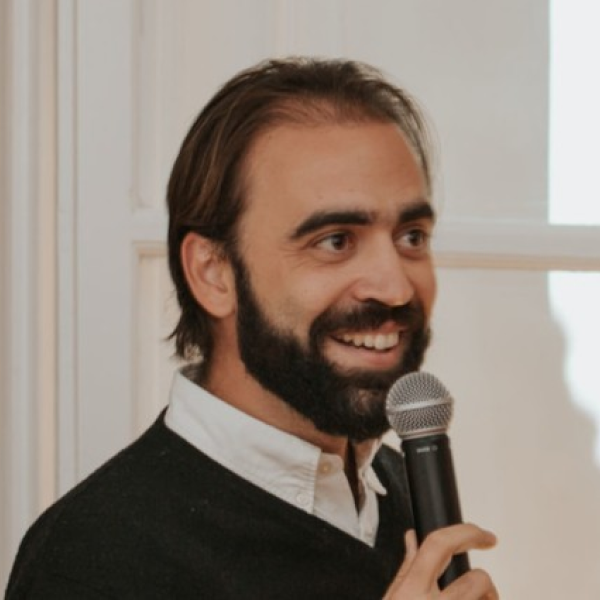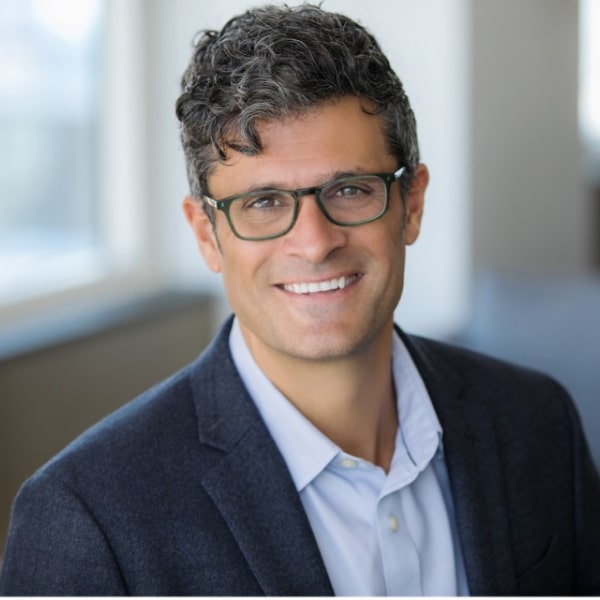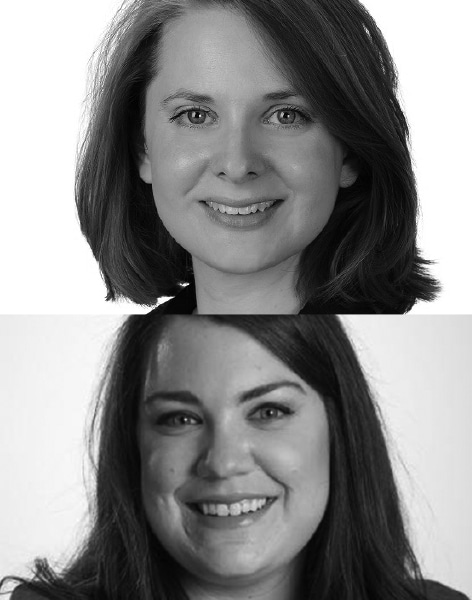Audio Advertising’s Big Leap in 2025
Paul Kelly
CEO of A Million Ads (AMA)

“Audio didn’t have the infrastructure to traffic a high volume of dynamic messages—until now.”
Paul Kelly
Paul Kelly, CEO of A Million Ads (AMA), joins us to explore the rapidly evolving world of personalized audio advertising.
Paul shares how AI is revolutionizing audio marketing, turning what was once a branding channel into a performance-driven powerhouse. He also talks about AMA’s Studio.AI tool that allows marketers to deliver hyper-personalized, dynamic audio ads at scale.
“Fragmented audiences require a sophisticated, AI-powered approach to reach at scale.”
Hear why podcasting, streaming audio and even audiobooks are becoming critical components of a media mix. Plus, discover how AI-driven tools can unlock new opportunities to reach diverse, fragmented audiences with messages tailored to location, time and behavior.
Highlights:
- The challenges of traditional audio advertising and digital migration
- How Studio.AI makes personalized audio ads simple and scalable
- Examples of real-time, location-based dynamic audio campaigns
- Podcasting’s growth to a billion-dollar business with dynamic ad insertion
- Predictions for the future of audio, including the rise of audiobooks
- Audience fragmentation and the importance of AI/ML tools for media optimization
- Shifting from narrow targeting to engaging adjacent customer segments
- The role of AI in delivering performance-focused audio strategies
- Why marketers need to integrate audio into their 2025 media plans
Watch the Live Recording
Tessa Burg: Hello, and welcome to another episode of “Leader Generation.” I’m your host, Tessa Burg, and today I am joined by Paul Kelly. He’s the Chief Revenue Officer of A Million Ads, also known as AMA. We’re very excited to have him. We’ll be talking about personalized audio advertising in 2025. Paul, thank you so much for joining us today.
Paul Kelly: Good morning, Tessa, and delighted to be here. Thank you for the opportunity.
Tessa Burg: It’s interesting to think about what audio is gonna be in 2025 after so much has happened in 2024 as it relates to AI and audio. And before we jump into this very big subject and give marketers just a preview of the opportunities they’ll have to really change their media mix and how they reach customers, tell us a little bit about yourself, your background, and role at AMA.
Paul Kelly: Sure. So, I started in the music business, actually pre-Spotify, which I suppose dates myself somewhat, but it was a very exciting time because it was right at that moment when peer-to-peer services were versioning and the new model wasn’t quite in place, but there was a real kind of fear as to whether a commercially viable model would exist for music. iTunes for a moment, you know, with the 99 cents download pointed at one way, but of course, that quickly became usurped by the all-you-can-eat subscription model, which of course dominates and defines not just media, but so much of commerce today as well, even in the retail sector with of course Walmart+ and the predecessor, Amazon Prime. So from the music industry, I then went into television effectively. So Warner Media Discovery, and then Viacom, all in kind of media sales and marketing roles before ultimately making the jump to audio and to ad tech specifically, which has been I think now three years here at AMA, and it’s been a fantastic journey.
Tessa Burg: That is an incredible background. I remember when they were first trying to monetize music and everyone was trying to get as much as they could for free until luckily artists took a stand and were like, “Hey, listen, “like, we made this original content.” So it’s funny ’cause my career has always been in protecting now the artist, and these monetization models make it possible for them to do what they do, but also for us to all get our content in a responsible way. And there have been some incredible changes and updates at AMA. In 2023, you launched Studio.AI, and just 12 months later surpassed 15 billion impressions. And for a point of comparison, that is five times more than your fellow Countrymen Ed Sheeran’s global hit, “Shape of You.” So tell us a little bit about Shape dot, oh, not Shape.AI, Studio.AI and the impact that it had at AMA.
Paul Kelly: Sure, so, the launch of of Studio.AI was borne from an insight, which really I think kind of changed how we think about the company and our platform. We used to go to clients and sell them on the benefit of lots of different messages, right? So changing the creative based on the listener’s context or preference, which of course from a theoretical level, holds true, right? If a message is more relevant, it’ll be more salient, it will embed memory structures better or it will prompt a behavioral response, which of course is the goal of a lot of advertising, not all. But what we didn’t fully appreciate, perhaps because audio was and maybe today still is kind of a separate silo to other digital channels. Like, digital audio is comparatively speaking quite young as a channel, as it’s kind of still migrating from terrestrial radio broadcast to digital. Spotify, of course, is relatively new, and podcasting is a medium, which we are broadcasting on right here, is also new. So, the infrastructure that had been built around display web advertising and then more recently social and social video already was built to handle, to traffic, to deliver a very, very high volume of messages. So once a big advertiser had, let’s just call it a Twitter, an X account, back in the day, there was then a demand to feed this algorithm, to feed the channel with content. So, our kind of realization was, was that, you know, many of our large clients are already producing, managing, distributing assets for other channels, predominantly visual assets, and there was systems, machinery built to make that work fluid, easier, right? To handle all of this kind of volume. Audio didn’t have that and clients were not aware that it could be executed in audio, I-E, rather than just limit this type of advertising to display and social channels, could we also use audio, which has typically been considered a branding channel or medium, in a more kind of performance-oriented capacity? And if yes, it became very clear to us that it would have to be just as simple, just as easy, just as turnkey as what clients are used to with the very advanced platforms that Google, Meta, and others have provided and continue to provide. And so that’s where Studio.AI was born, which was really a productized kind of version of what we already have as a dynamic ad server and dynamic creative studio, but more purpose-built to easily populate, and as I said, distribute slight variations of a core message based on the location, the time of day, specific, usually very time-specific type messaging, particularly for example, retail around flash sales, big tent pole sales events. And rather than just have, for example, one, here we are November 25th, I’m not sure when the episode will go out, but it’s Thanksgiving week. Rather than having the same Black Friday sale message for a two-week or 10-day period, we’re able to update that so that there’s certain products or product assortments are highlighted on particular days, or a countdown, for example, to particular doorbusters, et cetera. So the much kind of like social media, it enabled audio to be very, very real time, which from a digital audio perspective wasn’t really how that channel was activated to that point. And so Studio.AI was a real leg up in us helping to demonstrate clients not only the capability that this type of real time creative messaging can be deployed in digital audio, but it can be done simply. It can be done without having to get one’s head around a whole entire new system or set of processes, but rather it could just be a kind of a bolt-on extension of what’s kind of already being run in, as I said, in these other digital channels.
Tessa Burg: Yeah, and that’s a very big shift, because I think that when marketers think about audio, it also feels a little overwhelming. Like, there are so many different channels and it doesn’t feel like you can reach your specific target audience with a highly personalized message when all the podcasts are run under different organizations, you’re not sure how stable or how valid a network that reaches into them actually is. So, I know marketers are always thinking about performance and we know that the more personalized, the more timely, more relevant, the higher the performance. Who were some of the clients that have been through the Studio.AI experience and what were the results that they were seeing by being able to onboard audio into their overall marketing campaign?
Paul Kelly: Sure, so, I’d say a couple of good examples for, you know, retail is a very strong category for us, as is telco and travel. So, the Walmarts of the world, Target, Verizon in telco, and then, you know, the large travel operators, Expedia Group, et cetera. You know, being able to, for example, prompt spontaneous travel. So it’s a Wednesday or Tuesday maybe going into a holiday weekend. It’s a very opportune moment to pitch someone or that listener on a three-day long weekend getaway, right? But there’s no point in pitching me sitting in New York a quick weekend jaunt to California because that’s obviously not that convenient or close, but maybe Florida would be an option, or a city break to Boston. You get the idea. So versioning that for yourself in Ohio, forgive my ignorance, but I don’t know a, off the top of my head, a perfect weekend getaway that’s a short, 90-minute drive from where you are, but maybe you’ll educate me. But being able to run a scaled national audio campaign where every listener around the country is hearing about, “Oh, that actually is very doable for me “and quite appealing,” one can can naturally understand why that would be perhaps more effective and penetrating than just a more generic kind of static ad that isn’t able to be as specific in terms of referencing and conveying the experience that in this example Expedia are trying to get the listener to imagine.
Tessa Burg: I love that. And just for a little bit about Ohio, it depends on what age you are, so that’d be another important data point. You know, when I was younger, 90 minutes away is the islands in Lake Erie, and really that’s just a party. No matter how family friendly they try to make it, Kelleys Island, Put-in-Bay, good to go if you are going to dance your face off and drink. And then now as you get older, you go to Michigan, like. Where can I go and enjoy the lake without a party? But I love the hyper-personalization that drives a ton of results. As we look ahead into 2025, you recently posted on LinkedIn that podcast is now a billion dollar business driven by dynamic ad insertion, and I was surprised. I was like, “Holy crap.” I mean, I know there’s a lot of podcasts. I listen to a lot of podcasts, but what are some other things? As we look ahead into 2025 and the opportunities, what do you think marketers should know as they start to plan their budgets and how they’re gonna reach their audiences?
Paul Kelly: Yeah, so I said the word, I think I’ve said the word “silo” before. So it’s interesting because to this point, podcasting as a kind of channel within a channel, you know, it’s audio, but it’s been treated quite separately to digital or streaming audio at large. I think looking ahead, other silos are going to start to consolidate such that with the increase, for example, of audience buying and particularly programmatic in digital audio, being able to aggregate specific audiences across these different audio formats. Not just podcasting, but I would imagine quite soon audio books, which in my view, I have no horse in this race so to speak, but I think that if any scaled media enterprise will ultimately be ad-supported in some way, shape, or fashion, which I personally think is a solid bet, then I’m very, very bullish on audio books being kind of like a very, very material, substantive ad business over the next few years. I don’t think it will happen necessarily in 2025 because I think it’s difficult to launch an ad-supported product or offering in that space because of the rights involved and let’s say current air of cautiousness. But as the demand signal from consumers continues to kind of prove strong and increasingly unignorable, I think that, yeah, much like what we’ve seen in streaming video, audio books will become kind of like a really prominent part of the overall audio mix. That would include streaming audio, it would include podcasts, and in short order, I think it will also include broadcast radio. So now that audio has become more agile, more addressable, closer to what clients and advertisers are used to with the more established kind of digital channels that we touched on earlier, I think that we can expect to see more of the buying practices, specifically programmatic audience-led media buying, occur across audio as a holistic channel. And I’d like to think that AMA could play a role in helping x advertiser version the creative appropriately so that it is mindful of the environment such that if it’s an audio book, you know, you might wanna show up in a slightly different way than streaming audio, for example. So that’s, from our perspective, very interesting to see those different formats mature, and then from an advertising perspective, almost kind of aggregate into kind of one large audio channel mix.
Tessa Burg: Yeah, that is really exciting, and you’re right. I think the consumer demand or consumer movement toward digital audio isn’t going to reverse or stop. Like personally, I can’t remember the last time I listened to the radio. I am almost exclusively on podcasts and music on Spotify, and it’s even how I discover new music or new podcasts, just the technology that’s built into the audio platforms and their power of suggestion and recommendation. So if I am thinking about my media mix, where do I get started? Like, what kinds of assets serve as like the core assets that you version off of, and what do I need to know if anything about my audience and the amount of audio or digital audio they’re consuming before I approach something like an AMA in order to get the most out of it?
Paul Kelly: So, I mean, clearly the combination of media agency and the publishers provides tremendously valuable information with respect to audiences, consumption patterns, et cetera, so that’s very typically the starting point. As I often say, you know, if your ad, effectively, if your creative is say 15% or more on your car insurance, or let’s say 16% or more on your car insurance, it might well be that that media strategy and creative strategy is, we have one very clear asset and we have got a very broad target, in which case that’s gonna be a very, very different media plan than let’s say what podcasting. Or one of the things that podcasting has really done as a channel, which is to provide a very, very engaged, targeted audience around a specific lifestyle or passion. I mean, there’s many examples. We know the AG1 in the kind of health space of course is a useful case study, but there’s many others. So, I mean, that’s kind of like one, almost one side of the pendulum or spectrum to the other. So I think that is a useful starting place, and from there, you’re able to understand, well, what are the adjacent segments that may not be, for example, consuming fitness and health, motivational podcasting content? We’ve got those. I think as AG1 has grown, and you’ll see this with lots of other companies and new entrants in categories, then there’s less core users also become very valuable, marginal new customers, new clients, new customers, I should say. And so the media strategy then has to adjust. So, now we’ve got a whole and very valuable, addressable segment of consumers that don’t self-identify as a health nut but still care about and appreciate the ease and simplicity of having a scoop of green powder once a day as kind of like a great insurance against future malady down the line. Which again, a very different mindset to an individual who’s looking to kind of be the absolute top best form physical and mental shape that they can possibly be in, right? It’s just a, sorry for going on about a very, very specific example, but it’s kind of interesting that we see more and more cases of this, where you think the product is one thing, you think the brand is one thing, and it is a very clear proposition, but how it exists in the mind of the consumer is actually quite different when you look closely at these different segments. And so being able to tailor your message and your approach to those different kind of motivations is in our view really, really valuable, particularly in helping to grow brands and business from the initial core heavy user of a product.
Tessa Burg: Yeah, I think that message has been very consistent across our last few episodes and is so important to get back to really thinking about the motivation, the mindset, and the context of the audience you’re targeting. And we lost our way a little bit. Like earlier this year or midway through the year, I think everybody was very tech-focused, like, “What can I use to do things faster, better, cheaper?” And, Studio.AI, AMA offers that, but what you’re advising and I think is so important is to get the most out of these opportunities we have with tech is the time you’re saving using AI. The time now they don’t have to spend worrying about that burgeoning or personalization they should spend thinking about the audience and really crafting what it is they’re creating and what that message is for those different types of audiences, and using AI to get more on behavior data and less on people who self-identify. ‘Cause we all know, even ourselves, sometimes what we self-identify as is not who we are and it’s the little things that we do that really show what drives our purchase decisions, so I love that. I think it’s so important heading into 2025 for marketers. If you’re saving time in AI, reinvest in understanding the very specific needs of your customers. And that AG1 example resonated with me. I see that everywhere. So, my behavior doesn’t mean that I’m trying to prevent a future calamity.
Paul Kelly: Calamity, yeah.
Tessa Burg: I’m really the time, ’cause I’ve seen a bazillion ads and I’m like, “Man, this lion’s mane, “it’s gonna -”
Paul Kelly: Yeah. Well, it’s funny, you know, Mart Pritchard said it I think a couple of years ago quite famously, which was that the targeting as a kind of goal had led them to narrow their intended audiences to a counterproductive level in the sense that they were investing their advertising efforts towards people who were let’s say likely to already purchase the brand and had kind of ignored to their detriment those adjacent kind of segments that were still very, very valuable and worthy of investment, but perhaps just like we’re saying, had slightly different motivation or a less innate need for the particular product but were certainly persuadable. But if you’re targeting machine is so precise, it can lead you, as I said, to be blind to those very important audiences that contribute, ultimately are the ones that can contribute growth.
Tessa Burg: Right, and create demand, absolutely. So Paul, this has been a very interesting conversation. Lots to think about. Anything else you wanna add before we end our episode about the opportunities in audio, where the industry’s going or what marketers should do to prepare for 2025?
Paul Kelly: For 2025, I do think that as, there’s a couple of trends I think that we can rely on or bank on, one of which being is the fragmentation of audiences, which continues to disperse across different platforms, different kind of verticals within those platforms. And so having a sophisticated ML or AI-powered both media and creative optimization machine I don’t think is something to aim for, but rather increasingly something that’s just necessary for brands, as I say, that count more than one very, very tightly defined target as their addressable market, which for the vast majority of our clients are kind of large national brands that, as we’ve touched upon, really do count across different segments as their addressable market. And so as I said, taking advantage of the sophistication of the AI and ML tools for both media optimization as well as creative optimization is I think something that will become almost the default in 2025. You know, the recent news of Mediaocean and their acquisition with Flashtalking and Innovid I think, you know, kind of points to that truth. It’s a big bet on, as I said, cross channel media and creative optimization at scale.
Tessa Burg: I couldn’t agree more. So if you are listening to this episode and you wanna make sure that AI ML automation is a part of your plan, because that’s where you’re gonna pick up those behaviors to make the most of those adjacent audiences and create demand in a way that’s personalized and highly relevant, if we’re you’re agency, contact us. But if not, ask your agency and definitely make audio a part of your media mix in 2025. It is only going to grow. Paul, thank you so much for joining us today. It’s been a great conversation and I hope that we get to connect again sometime next year.
Paul Kelly: I certainly do as well. Thank you, Tessa. Great fun talking to you.
Tessa Burg: If you wanna hear more episodes of “Leader Generation,” you can find them at modop.com. That’s M-O-D-O-P.com. You can find Paul Kelly and AMA on LinkedIn or on their website, A Million Ads. And until next time, find us on anywhere you listen to your podcasts, and we will talk again soon.
Paul Kelly
CEO of A Million Ads (AMA)

Paul Kelly is the CEO of A Million Ads (AMA). AMA is the leader in Dynamic Creative for audio, delivering customized, data-driven, dynamic ads on the world’s largest audio platforms. Using any combination of contextual and audience-level data, AMA dynamically serves the most relevant and actionable ad to each listener.


